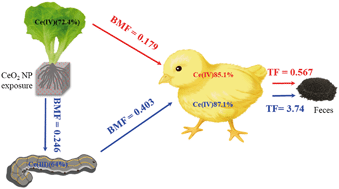当前位置:
X-MOL 学术
›
Environ. Sci.: Nano
›
论文详情
Our official English website, www.x-mol.net, welcomes your
feedback! (Note: you will need to create a separate account there.)
Transfer and transformation of CeO2 NPs along a terrestrial trophic food chain
Environmental Science: Nano ( IF 5.8 ) Pub Date : 2019/12/20 , DOI: 10.1039/c9en01143a Yanhui Dai 1, 2, 3, 4, 5 , Zhenyu Wang 1, 2, 3, 4, 5 , Lei Zhang 5, 6, 7, 8, 9 , Zhixiang Jiang 5, 10, 11, 12, 13 , Shengyan Pu 5, 14, 15, 16 , Qiaohui Fan 5, 17, 18, 19 , Jian Zhao 5, 6, 7, 8, 9 , Baoshan Xing 13, 20, 21, 22
Environmental Science: Nano ( IF 5.8 ) Pub Date : 2019/12/20 , DOI: 10.1039/c9en01143a Yanhui Dai 1, 2, 3, 4, 5 , Zhenyu Wang 1, 2, 3, 4, 5 , Lei Zhang 5, 6, 7, 8, 9 , Zhixiang Jiang 5, 10, 11, 12, 13 , Shengyan Pu 5, 14, 15, 16 , Qiaohui Fan 5, 17, 18, 19 , Jian Zhao 5, 6, 7, 8, 9 , Baoshan Xing 13, 20, 21, 22
Affiliation

|
CeO2 NPs could be inevitably exposed to terrestrial organisms and food chains with their agricultural applications. The transfer and transformation of CeO2 NPs were therefore investigated within a tri-trophic terrestrial food chain, i.e., lettuce–hornworm–chicken. The results showed that CeO2 NPs were accumulated by lettuce (Lactuca sativa L.) roots and translocated to leaves in a dose-dependent manner after exposure to CeO2 NPs (2–1000 mg L−1) for 10 days via roots. The obtained CeO2 NP-containing leaves (14.37, 35.71 mg Ce per kg dry weight) were fed to hornworms (Spodoptera litura F.). The Ce contents in hornworms were 6.78 and 8.78 mg per kg dry weight, respectively, and the majority of Ce (13.51 and 26.03 mg per kg dry weight, respectively) was excreted to feces. In the case of chickens (Gallus gallus domesticus), Ce was mainly distributed in their intestines and stomachs from leaf and hornworm dietaries. Biomagnification factors of CeO2 NPs were 0.179, 0.246 and 0.403 after the transfers through lettuce–chicken, lettuce–hornworm, and hornworm–chicken, respectively, suggesting that no biomagnification occurred during both bi- and tri-trophic food chain exposures. As detected by X-ray absorption near edge structure, Ce primarily remained as CeO2 in the lettuce roots (83.4%) and leaves (72.4%) after root exposure, Ce(III)-cysteine (52.1%) in the hornworms under trophic exposure, and CeO2 in the intestines (85.1 and 87.1%, respectively) of chickens after leaf and hornworm dietaries. These results indicated that the transfer and transformation of CeO2 NPs are independent of the number of trophic levels. This research provides further insight into the fate of NPs in terrestrial ecosystems and their possible risks to food safety.
中文翻译:

CeO2 NPs在陆地营养食物链中的转移和转化
随着其农业应用的发展,CeO 2 NPs不可避免地会暴露于陆地生物和食物链中。因此,研究了三营养地球食物链中的CeO 2 NPs的转移和转化,即生菜-horn虫-鸡。结果表明,CeO 2 NPs累积在莴苣(Lactuca sativa L.)的根部,并通过根系暴露于CeO 2 NPs(2-1000 mg L -1)达10天后,以剂量依赖的方式转移到叶片上。将获得的含CeO 2 NP的叶子(每公斤干重14.37,35.71 mg Ce)喂入天蛾(斜纹夜蛾)F。)。中的Ce含量分别为每公斤干重6.78和8.78 mg,大部分Ce(分别为每公斤干重13.51和26.03 mg)排泄到粪便中。就鸡(鸡)而言,铈主要分布在叶和角虫饮食中的肠和胃中。通过生菜-鸡肉,生菜-horn虫和let虫-鸡肉转移后,CeO 2 NPs的生物放大系数分别为0.179、0.246和0.403,这表明在双营养和三营养食物链暴露期间均未发生生物放大。通过边缘结构附近的X射线吸收检测,根暴露后,Ce主要作为CeO 2保留在莴苣根中(83.4%)和叶中(72.4%),Ce(III在暴露于营养后的oph中,半胱氨酸(52.1%)和小肠中的CeO 2(分别为85.1和87.1%)。这些结果表明,CeO 2 NPs的转移和转化与营养级数无关。这项研究提供了关于陆地生态系统中NP的命运及其对食品安全的潜在风险的进一步见解。
更新日期:2020-02-20
中文翻译:

CeO2 NPs在陆地营养食物链中的转移和转化
随着其农业应用的发展,CeO 2 NPs不可避免地会暴露于陆地生物和食物链中。因此,研究了三营养地球食物链中的CeO 2 NPs的转移和转化,即生菜-horn虫-鸡。结果表明,CeO 2 NPs累积在莴苣(Lactuca sativa L.)的根部,并通过根系暴露于CeO 2 NPs(2-1000 mg L -1)达10天后,以剂量依赖的方式转移到叶片上。将获得的含CeO 2 NP的叶子(每公斤干重14.37,35.71 mg Ce)喂入天蛾(斜纹夜蛾)F。)。中的Ce含量分别为每公斤干重6.78和8.78 mg,大部分Ce(分别为每公斤干重13.51和26.03 mg)排泄到粪便中。就鸡(鸡)而言,铈主要分布在叶和角虫饮食中的肠和胃中。通过生菜-鸡肉,生菜-horn虫和let虫-鸡肉转移后,CeO 2 NPs的生物放大系数分别为0.179、0.246和0.403,这表明在双营养和三营养食物链暴露期间均未发生生物放大。通过边缘结构附近的X射线吸收检测,根暴露后,Ce主要作为CeO 2保留在莴苣根中(83.4%)和叶中(72.4%),Ce(III在暴露于营养后的oph中,半胱氨酸(52.1%)和小肠中的CeO 2(分别为85.1和87.1%)。这些结果表明,CeO 2 NPs的转移和转化与营养级数无关。这项研究提供了关于陆地生态系统中NP的命运及其对食品安全的潜在风险的进一步见解。











































 京公网安备 11010802027423号
京公网安备 11010802027423号